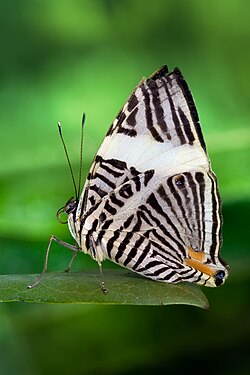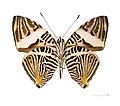| Zebra mosaic | |
|---|---|
 | |
| Scientific classification | |
| Kingdom: | Animalia |
| Phylum: | Arthropoda |
| Class: | Insecta |
| Order: | Lepidoptera |
| Family: | Nymphalidae |
| Genus: | Colobura |
| Species: | C. dirce |
| Binomial name | |
| Colobura dirce | |
 | |
| Approximate range of the Dirce beauty note: Caribbean sightings missing | |
| Synonyms | |
| |
Colobura dirce, the mosaic or zebra mosaic, is a butterfly of the family Nymphalidae. It is found in Central America. the Caribbean, and northern South America.
The length of the forewings is about 33 mm.
The larvae feed on Cecropia species.
- Male, topside, MHNT
- Male, underside, MHNT

